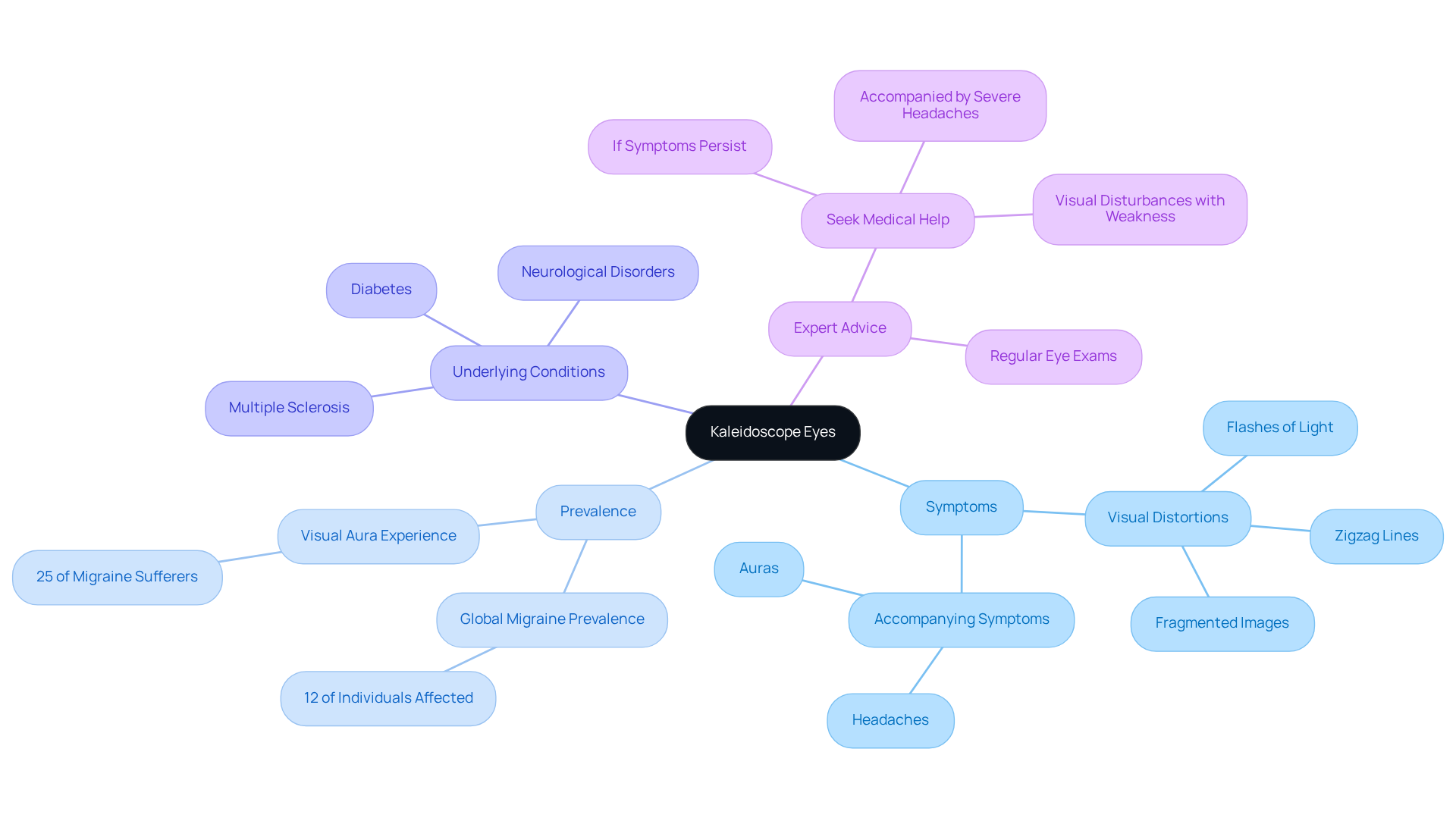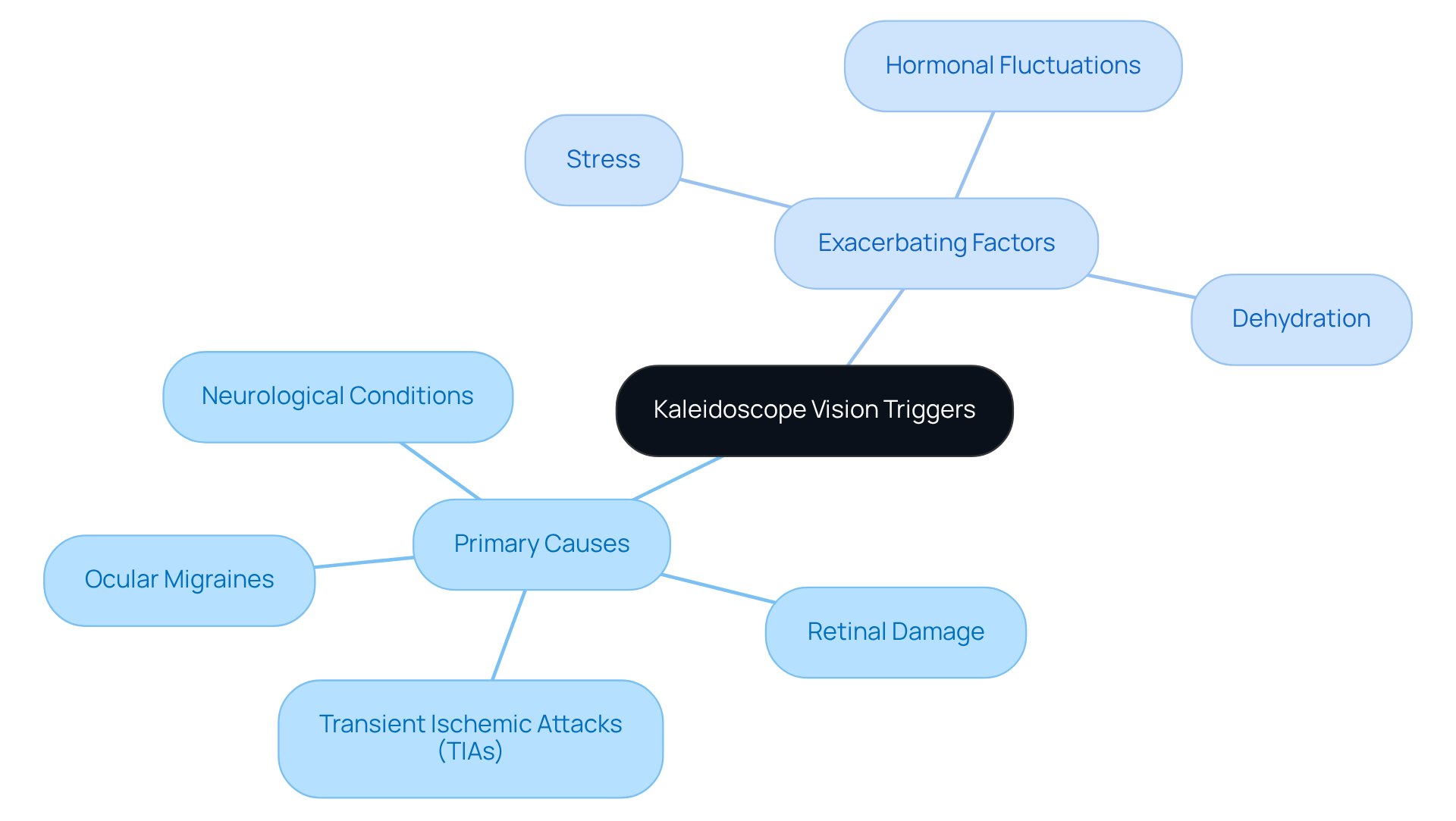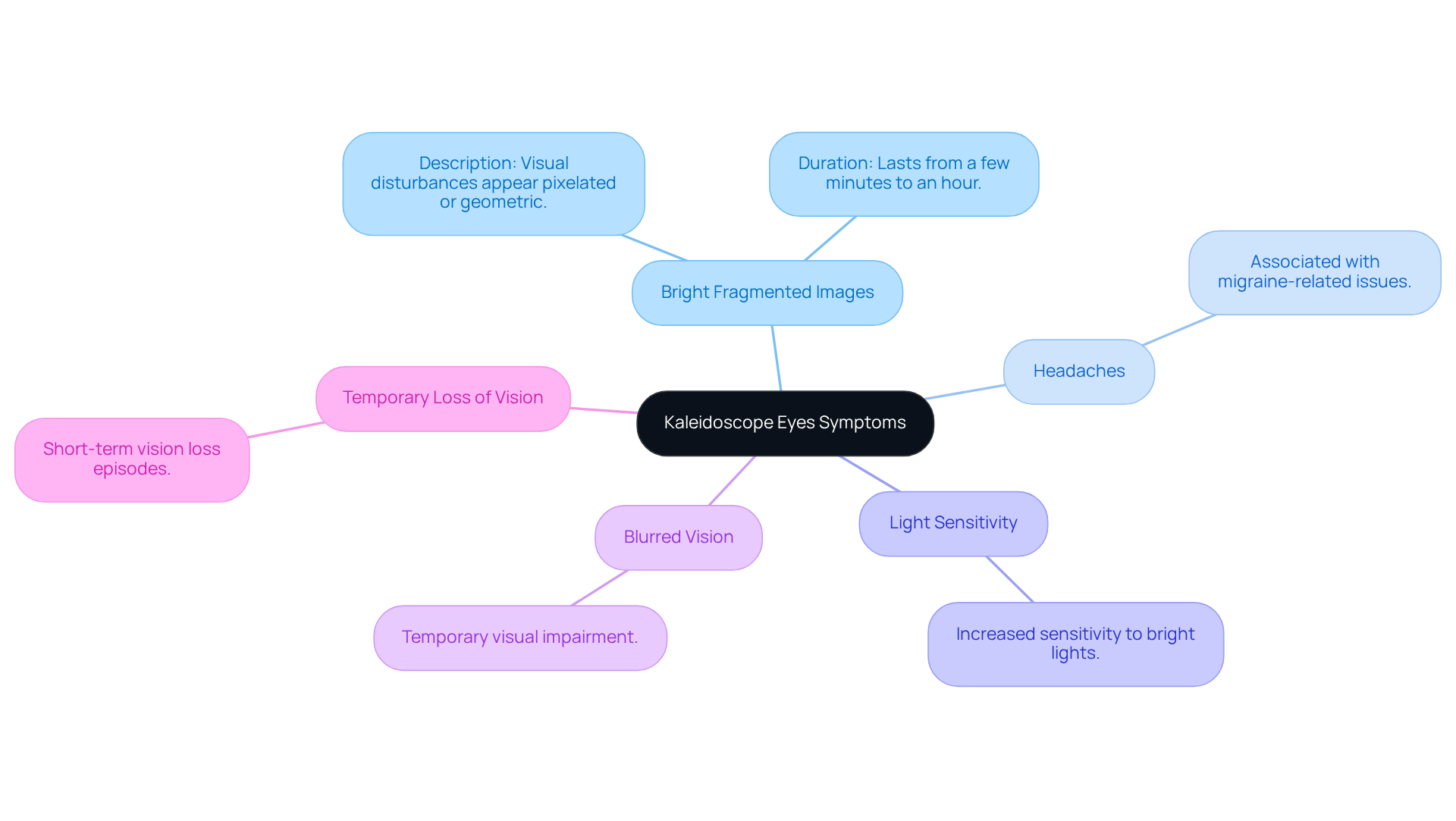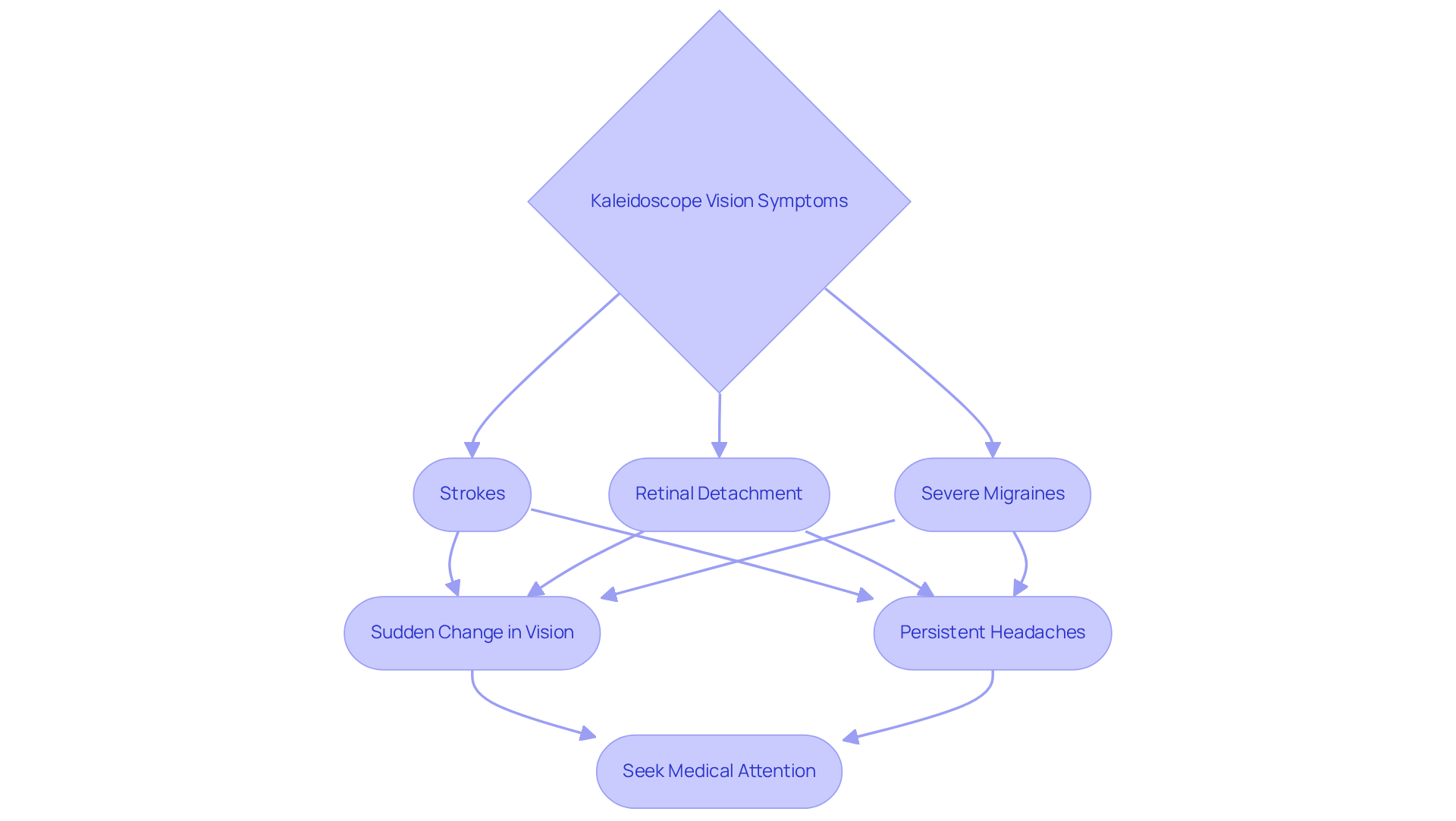Posted by: Northwest Eye in General on September 29, 2025
Overview
Kaleidoscope eyes refer to a visual phenomenon that can be quite concerning. This phenomenon is characterized by distorted images resembling colorful, fragmented patterns. It’s important to understand that these visual disturbances often indicate underlying health issues, such as migraines or neurological disorders.
We understand that experiencing kaleidoscope eyes can be unsettling. These visual disturbances can be triggered by various factors, including:
- Ocular migraines
- Stress
- Dehydration
Recognizing these triggers is crucial. Accompanying symptoms should not be ignored, as they can guide you to seek timely medical intervention.
We are here to help you through this process. If you notice these symptoms, it’s common to feel anxious or uncertain. Remember, addressing your concerns with a healthcare professional can provide reassurance and clarity.
Introduction
Kaleidoscope eyes present a fascinating yet alarming visual phenomenon. Individuals experiencing this perceive a world distorted into vibrant, fragmented patterns. We understand that this condition, often linked to migraines and other neurological disorders, can be unsettling. It serves as a crucial signal for underlying health issues that may require immediate attention.
What happens, however, when these colorful distortions become a frequent occurrence? It’s common to feel anxious about such changes in your vision. Understanding the causes, symptoms, and potential implications of kaleidoscope vision is essential for anyone experiencing these unsettling visual disturbances. This knowledge can lead to timely medical intervention and better management of health conditions. We are here to help you through this process.
Define Kaleidoscope Eyes: An Overview of the Condition
Kaleidoscope eyes refer to a phenomenon where individuals perceive distorted images resembling views through a pattern of changing shapes. We understand that experiencing such distortions can be unsettling. This condition may manifest as fragmented, multi-hued images, frequently accompanied by symptoms like headaches or auras. While isn’t classified as an independent diagnosis, it serves as an important indicator of several underlying conditions, such as migraines and neurological disorders. Recognizing this phenomenon is crucial for understanding its implications and seeking appropriate medical advice.
About 12% of individuals worldwide are affected by migraines, and around 25% of those with migraines experience visual aura effects, including colorful patterns. These episodes can last anywhere from 10 to 30 minutes but may extend up to an hour. This prevalence highlights the importance of understanding multifaceted perceptions within the broader context of migraine-related experiences.
Experts emphasize the need to identify the signs linked to distorted perception. Symptoms might include visual distortions, such as zigzag lines or flashes of light, which can indicate more serious conditions like strokes or retinal damage. We encourage you to seek guidance from a healthcare professional if you frequently experience distorted sight or if it is accompanied by other concerning symptoms, such as intense headaches or vision loss. Dr. Nicole Bajic, an ophthalmologist, advises, “If you experience a sudden intense headache along with sight disturbances like distorted patterns, seek urgent medical assistance.”
Additionally, multicolored sight can be associated with conditions such as diabetes or multiple sclerosis, which may increase the likelihood of perceptual disturbances. These disruptions are categorized into positive, negative, and altered auras, providing a broader understanding of the types of manifestations linked with colorful sight.
In summary, kaleidoscope eyes are a perceptual manifestation that deserves attention, especially when they occur alongside other concerning symptoms. Understanding its implications can lead to timely medical intervention and better management of underlying conditions. Remember, we are here to help you through this process.

Identify Causes: Understanding What Triggers Kaleidoscope Vision
Kaleidoscope eyes can understandably be concerning, and they can be triggered by several factors, most commonly linked to ocular migraines. During an ocular migraine, you might experience sight disturbances before a headache, resulting in kaleidoscope eyes. Other potential causes can include:
- Retinal damage
- Transient ischemic attacks (TIAs)
- Certain neurological conditions
It’s also important to recognize that:
- Stress
- Dehydration
- Hormonal fluctuations
can exacerbate these visual disturbances.
We understand that comprehending these triggers is essential for anyone encountering distorted sight. Recognizing these signs can empower you to know when it’s time to pursue medical care. You’re not alone in this experience, and we are here to .

Recognize Symptoms: Key Indicators of Kaleidoscope Eyes
Symptoms associated with kaleidoscope eyes can be quite concerning, often manifesting as bright, fragmented images that may seem pixelated or geometric. We understand that these visual disturbances can last from a few minutes to an hour, and they are frequently accompanied by headaches or other migraine-related issues. Additionally, you might experience light sensitivity, blurred vision, or even temporary loss of vision.
Identifying these signs is crucial, as they may indicate underlying health concerns that require prompt medical assessment. At Northwest Eye, we are here to help you through this process. If you encounter these symptoms, we urge you to seek professional medical assistance. Unaddressed conditions can lead to , and we want to ensure you receive the care you need.

Explore Implications: Health Concerns Related to Kaleidoscope Vision
Kaleidoscopic perception can be concerning, especially when it occurs frequently or is accompanied by other troubling signs. We understand that experiencing these symptoms can be unsettling. Conditions such as strokes, retinal detachment, or severe migraines may present with visual disturbances characterized by kaleidoscope eyes.
If you notice sudden changes in your vision, persistent headaches, or any other neurological signs, it’s important to seek medical attention. Early intervention can be critical in preventing more severe complications and ensuring you receive the proper care you deserve.
Remember, we are here to .

Conclusion
Kaleidoscope eyes represent a significant visual phenomenon that can indicate various underlying health issues. We understand that experiencing this condition can be concerning, and recognizing it is essential, as it may serve as a warning sign for more serious medical concerns. Understanding the implications of kaleidoscope vision is crucial for seeking timely medical advice and ensuring appropriate care.
Throughout this article, we have discussed key points, including:
- The definition of kaleidoscope eyes
- Common triggers such as ocular migraines and stress
- The symptoms that accompany this visual distortion
It’s important to note the connection between kaleidoscope vision and serious health conditions like strokes or retinal damage. This highlights the importance of vigilance and prompt medical evaluation.
Ultimately, awareness and understanding of kaleidoscope eyes can empower you to take proactive steps regarding your health. If you are experiencing this phenomenon, especially in conjunction with other concerning symptoms, seeking professional medical assistance is vital. By doing so, you can ensure you receive the necessary care and mitigate potential risks associated with this condition. Remember, we are here to help you through this process.
Frequently Asked Questions
What are kaleidoscope eyes?
Kaleidoscope eyes refer to a phenomenon where individuals perceive distorted images that resemble views through a pattern of changing shapes, often manifesting as fragmented, multi-hued images.
What symptoms accompany kaleidoscope eyes?
Symptoms may include headaches, auras, and visual distortions such as zigzag lines or flashes of light.
Is kaleidoscope eyes an independent diagnosis?
No, kaleidoscope eyes are not classified as an independent diagnosis but are an important indicator of several underlying conditions, such as migraines and neurological disorders.
How common are migraines and their visual aura effects?
About 12% of individuals worldwide are affected by migraines, and around 25% of those with migraines experience visual aura effects, including colorful patterns.
How long do episodes of kaleidoscope eyes typically last?
These episodes can last anywhere from 10 to 30 minutes but may extend up to an hour.
What should I do if I frequently experience distorted sight?
It is important to seek guidance from a healthcare professional if you frequently experience distorted sight, especially if it is accompanied by other concerning symptoms like intense headaches or vision loss.
What serious conditions can distorted perception indicate?
Distorted perception can indicate more serious conditions such as strokes or retinal damage.
What other conditions can be associated with kaleidoscope eyes?
Kaleidoscope eyes can also be associated with conditions such as diabetes or multiple sclerosis, which may increase the likelihood of perceptual disturbances.
What are the types of auras related to kaleidoscope eyes?
Disruptions related to kaleidoscope eyes are categorized into positive, negative, and altered auras.
Why is it important to understand kaleidoscope eyes?
Understanding kaleidoscope eyes is crucial for recognizing its implications, which can lead to timely medical intervention and better management of underlying conditions.






